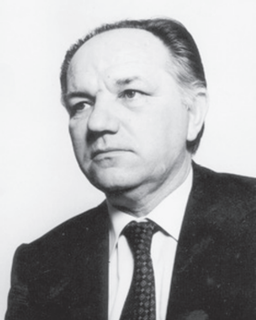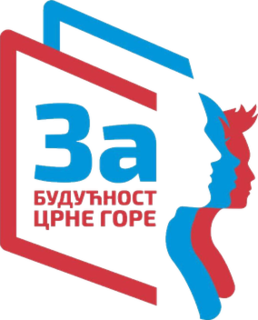Related Research Articles
Montenegrin is a normative variety of the Serbo-Croatian language mainly used by Montenegrins and is the official language of Montenegro. Montenegrin is based on the most widespread dialect of Serbo-Croatian, Shtokavian, more specifically on Eastern Herzegovinian, which is also the basis of Standard Croatian, Serbian, and Bosnian.

Petar Lubarda was a Serbian and Yugoslav painter.
The Armed Forces of Montenegro consists of an army, navy and air force. The military is a standing army.

Božina M. Ivanović was a Montenegrin anthropologist and politician. He served as General Secretary of the Montenegrin Academy of Sciences and Arts and President of Matica crnogorska. He was a professor at the Faculty of Science and Mathematics, University of Montenegro.
The culture of Montenegro is as pluralistic and diverse as its history and geographical position would suggest. Montenegro's culture has drawn influences mainly from Ancient Rome, Christianity, Islam, the Byzantine Empire, the Ottoman Empire, the Republic of Venice, Austria-Hungary, and Yugoslavia.

Dr. Nikola "Niko" Miljanić a Montenegrin and Serbian anatomist and surgeon, professor of anatomy at Belgrade Medical School, resistance participant during World War II and the president of Montenegrin wartime Assembly.
The State Anti-fascist Council for the National Liberation of Montenegro and Boka (ZAVNOCGB/ЗABHOЦГиБ) was formed as the highest governing institution of the anti-fascist resistance movement in Montenegro, in the former Kingdom of Yugoslavia.
The Montenegrin Men's Handball Cup is an elimination handball tournament held annually. It is the second most important national title in Montenegrin handball after the Montenegrin First League.
Dimitrije Popović is an eminent Montenegrin and Croatian painter, sculptor, art critic and philosopher born in Cetinje, Montenegro. He attended elementary and high school in his hometown and graduated from the Academy of Fine Arts in Zagreb in 1976 in the class of professor Šime Perić.

Rail transport in Montenegro is operated by four separate companies, which independently handle railway infrastructure, passenger transport, cargo transport and maintenance of the rolling stock. The four companies were a part of public company Railways of Montenegro until it was split up in 2008.
Miloš Vušković (1900–1975) was a Montenegrin painter illustrator, caricaturist and professor of visual arts, member of CANU and ULUCG.

Gojko Čelebić is a Montenegrin writer and diplomat.

The University of Montenegro Faculty of Drama is one of the educational institutions of the University of Montenegro. The Faculty is located in Cetinje, in the building of the former Turkish embassy to Montenegro.

The University of Montenegro Faculty of Law, also known as the Podgorica Law School, is one of the educational institutions of the University of Montenegro. The Faculty is Montenegro's leading law school.
Sreten Asanović was a Montenegrin author who established the short-story genre in that country. Asanović was born in Donji Kokoti, near Podgorica. He completed teacher-training school, focusing on preschool education.
The Montenegrin Volleyball League is the highest level of men's volleyball in Montenegro and it is organized by Montenegrin Volleyball Federation. In the Montenegrin Volleyball League currently competes 8 clubs.
Wilhelm Keiper was a Generalmajor in the Wehrmacht of Nazi Germany during World War II. Between September 1943 and November 1944 he was the German plenipotentiary general of the German occupied territory of Montenegro.

For the Future of Montenegro was a catch-all, mainly cultural conservative and populist pre-election opposition political coalition in Montenegro, formed for the August 2020 parliamentary election. The coalition common list for 2020 election is led by a Montenegrin university professor, Zdravko Krivokapić.

Zdravko Krivokapić is a Montenegrin mechanical engineering professor, writer, and politician serving as the Prime Minister of Montenegro since 4 December 2020. In addition to his professorship at the Universities of Montenegro and East Sarajevo, he is one of the founders of the non-governmental organization called "We won't give up Montenegro", which was founded by Montenegrin professors and intellectuals in support of the Serbian Orthodox Church in Montenegro after a controversial religion law targeted the legal status and the property of the Church. His political views and public appearances are generally defined as moderate right, anti-corruption, Christian democratic, pro-European, and economically liberal, as well as pro-church, supportive of ethnic Serb interests, and culturally conservative.

Ratko Mitrović, PhD, Sc.D is a Montenegrin civil engineer, university professor and politician, serving as Minister of Ecology, Spatial Planning and Urbanism of Montenegro in the cabinet of Zdravko Krivokapić, since December 2020. In addition to his academic career at the University of Montenegro, he is one of the founders of the non-governmental organization called "We won't give up Montenegro", which was founded by Montenegrin professors and intellectuals in support of the Serbian Orthodox Church in Montenegro after a controversial religion law targeted the legal status and the property of the Church.
References
1. Pavle Vasić, Jubilarna izložba crnogorskih umjetnika (In occasion of the jubilee exhibition of Montenegrin painters), Politika (Serbian newspaper Politika), 28. 11. 1956.
2. Dragutin Vujanović, Predgovor u katalogu za izložbu Gojka Berkuljana (From the preface to the catalogue), Radnički univerzitet «Nikola Kovačević», Nikšić 1972.
3. Milan Marović, Predgovor u katalogu za izložbu (From the preface to the catalogue), Umjetnička galerija Crne Gore, Cetinje 1973.
4. Olga Perović, Ovdje (Former Montenegrin art magazine), September 1973.
5. Mladen Lompar, Gojko Berkuljan – katalog retrospektivne izložbe (From the catalogue published in occasion of Berkuljan’s retrospective), Umjetnički muzej SR Crne Gore Cetinje, jul-August 1977.
6. Milo Kralj, Stvaralaštvo je stalno traženje (The creativity represents the continuous seeking), Borba (Serbian newspaper Borba), 9. 04. 1977.
7. Opća enciklopedija JLZ – treće izdanje, tom II, str 151 (Third version, vol. II, page 151), Zagreb 1977.
8. Anton Zadrima, Crnogorski slikari i vajari (Montenegrin painters and sculptors), Književna opština Cetinje, 1986.
9. Olga Perović, Ogledi i kritike (Opinions and art criticism), Centar savremene umjetnosti Crne Gore, Podgorica, 1997.
10. Milan M. Marović, Prostor/vrijeme/trajanje – crnogorska likovna kritika (Space/time/existence – Montenegrin art criticism), Centar savremene umjetnosti Crne Gore, Podgorica, 2000.